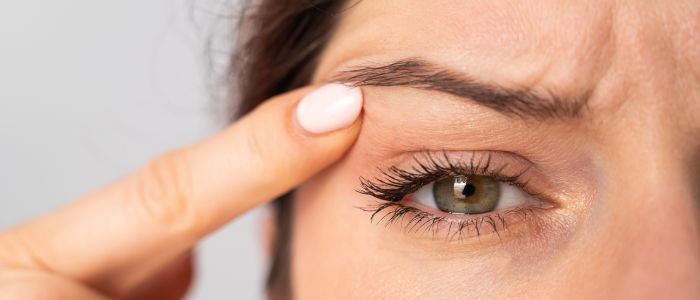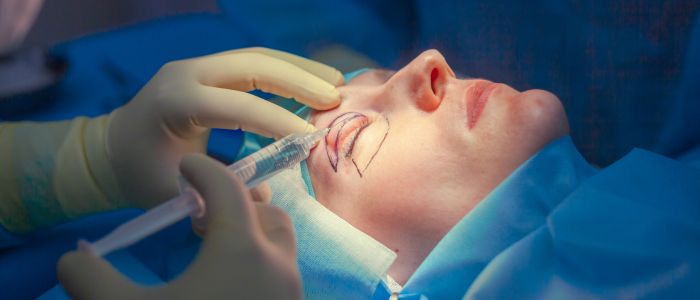
Table of Contents
- A Guide to Treating Droopy Eyelids
- Causes of Droopy Eyelids
- Treatments for Droopy Eyelids
- Surgical Treatments
- Types of Surgical Procedures for Droopy Eyelids
- Pre-Surgical Considerations
- Surgical Process
- Post-Surgical Care and Recovery
- Expected Outcomes
- When to see Consultant Plastic Surgeon Anca Breahna
- Droopy Eyelids Prevention Tips
- FAQs about Treatment and Solutions for Droopy Eyelids
- Further Reading about Eyelid Surgery at Cheshire Cosmetic Surgery
A Guide to Treating Droopy Eyelids
Droopy eyelids, medically known as ptosis, can be a source of discomfort and significantly affect your vision and quality of life. This condition, where the upper eyelid falls to a lower position than normal, can be either congenital or develop later in life, potentially affecting one or both eyes. In this blog, Consultant Plastic, Reconstructive and Aesthetic Surgeon Anca Breahna guides you through understanding the various symptoms, causes, and treatment options available. If you’re experiencing ptosis, you might notice a sagging of the upper eyelids, which can sometimes cover the pupil and interfere with your vision, leading to a reduced field of vision. This often results in the need to frequently raise your eyebrows in an attempt to see better, causing headaches and fatigue. Other symptoms include difficulty keeping your eyelids open, eye strain, and an increased effort required to maintain clear vision, all of which underscore the importance of addressing this condition effectively.
Causes of Droopy Eyelids
The causes of droopy eyelids, or ptosis, are diverse and understanding them is fundamental to determining the most appropriate treatment approach. Here is a look at the various factors that can lead to this condition:
- Ageing: One of the most common causes of ptosis is the natural ageing process. As you age, the muscles that lift your eyelids, primarily the levator muscles, gradually weaken. This weakening can cause the eyelids to sag. The connective tissues that support these muscles can also stretch and weaken over time, exacerbating the drooping effect.
- Genetic Factors: In some cases, ptosis is congenital, meaning individuals are born with the condition. This can occur due to developmental issues that affect the muscles or nerves associated with eyelid function. Families may notice a history of droopy eyelids across generations, indicating a hereditary link.
- Neurological Conditions: Various neurological disorders can impact the nerves that control the eyelid muscles. Conditions such as myasthenia gravis, which affects the communication between nerves and muscles, can lead to ptosis. Similarly, a stroke or brain aneurysm that affects certain brain areas or cranial nerves can result in eyelid drooping.
- Trauma and Injury: Physical injury to the eye or the orbit can damage the muscles or nerves responsible for lifting the eyelid. Trauma might occur due to accidents, surgeries, or even after less invasive procedures that inadvertently affect the eyelid’s function.
- Complications from Surgery: Surgical procedures near the eyelids, such as those performed for cataract removal, LASIK, or cosmetic surgeries like eyelid lifts, can sometimes lead to ptosis. This can be due to scarring, nerve damage, or disruption of the muscle functions during the operation.
- Medical Conditions: Some medical conditions, unrelated to the neurological or genetic factors, can also lead to ptosis. For example, diabetes can cause nerve damage that affects the eyes, and tumours or swellings in or around the eye can mechanically cause the eyelid to droop by weighing it down.
If you suspect you have ptosis, it’s important to consult with Anca. An early consultation can help prevent potential complications, especially if your vision is affected. During your visit, you should provide a complete medical history and describe any symptoms in detail to help with an accurate diagnosis.
The diagnosis of droopy eyelids usually involves a physical examination and specific tests conducted by Anca. These might involve measuring the strength of the eyelid muscles. In some cases, imaging tests are required to rule out underlying causes such as tumours or nerve damage.
Treatments for Droopy Eyelids
Making certain lifestyle adjustments can help manage mild cases of droopy eyelids. Maintaining a healthy weight, reducing salt intake to prevent fluid retention, and ensuring that you get enough sleep are practical steps you can take. Additionally, exercises that strengthen the muscles around the eyes may be beneficial, although their effectiveness can vary.
In cases where droopy eyelids are caused by an underlying condition, such as an infection or inflammation, medications may be prescribed to treat the root cause. There are also specific drugs that can stimulate the muscles that lift the eyelid, although these are not suitable for everyone and can have side effects.
Surgical Treatments
This type of surgery aims to correct the position of the eyelid, enhance visual function, and improve facial symmetry and aesthetics. Here is a description of the different surgical options available, their processes, and considerations:
Types of Surgical Procedures for Droopy Eyelids
- Levator Aponeurosis Repair: This is the most common surgery for adults with ptosis and involves tightening the levator muscle that lifts the eyelid. This procedure adjusts the muscle or its tendon to help raise the eyelid to a more desirable position.
- Müller’s Muscle-Conjunctival Resection (MMCR): Suitable for milder forms of ptosis, this procedure targets Müller’s muscle, a secondary eyelid lifter, to provide lift to the eyelid with less extensive surgery than a traditional levator repair.
- Frontalis Sling Operation: Often used when the levator muscle is very weak or non-functional. This technique involves using a small sling that connects the eyelid to the forehead muscle, allowing the forehead muscles to assist in lifting the eyelid.
Pre-Surgical Considerations
- Medical Evaluation: Assessment of your overall health and eye condition to determine the most appropriate type of surgery.
- Severity and Cause of Ptosis: Determining whether the ptosis is due to muscle weakness, nerve damage, or other reasons to choose the suitable surgical approach.
- Patient’s Expectations: Discussing potential outcomes and setting realistic expectations for the results of the surgery.
Surgical Process
- Anaesthesia: Depending on the complexity, the surgery may be done under local or general anaesthesia.
- Incision and Correction: Strategic incisions are made along the natural lines of the eyelids. The muscle is then shortened or reattached to lift the eyelid to its new position.
- Duration: The procedure generally takes between 45 minutes to 2 hours depending on the complexity and whether one or both eyelids are being corrected.
Post-Surgical Care and Recovery
- Initial Recovery: You might experience swelling and bruising for the first few weeks. Cold compresses and head elevation can help minimise these effects.
- Follow-up Visits: Essential for monitoring the healing process and the success of the operation.
- Activity Restrictions: You are generally advised to avoid strenuous activities and to protect their eyes from excessive light and dust.
Expected Outcomes
- Improvement in Vision and Appearance: The surgery can significantly improve peripheral vision and the overall appearance of the eyes.
- Long-term Results: While some cases might need adjustments or revisions, most surgical corrections are long-lasting.
Surgical intervention for droopy eyelids is highly effective and can profoundly impact your functional abilities and aesthetic look.
When to see Consultant Plastic Surgeon Anca Breahna
Recognising when to consult a surgeon for droopy eyelids is important for timely and effective treatment. Ptosis can not only affect your appearance but also interfere with your vision and, in some cases, may signal underlying health issues. Here are main indications and considerations that should prompt a visit to Anca:
- Noticeable Change in Eyelid Position: If you observe that one or both of your eyelids have begun to droop noticeably, it’s important to consult with a doctor. A change in the eyelid’s position can gradually or suddenly occur, and noticing this change is the first step in addressing any potential issues.
- Vision Impairment: Any interference with your vision, such as difficulties in keeping a full field of sight, which forces you to tilt your head back or lift your chin to see clearly, warrants medical attention. This can impact your ability to perform daily tasks safely, particularly driving and reading.
- Asymmetry Between the Eyelids: If one eyelid appears different from the other or there’s a new asymmetry, it might be indicative of ptosis. Asymmetry can lead to complications like eye strain or headaches due to the extra effort needed to maintain clear vision.
- Physical Discomfort or Strain: Symptoms such as increased effort to keep your eyelids open, frequent forehead headaches from straining the muscles around your eyes, or feeling the need to raise your eyebrows for better vision are signs that you should see a doctor.
- Rapid Onset of Symptoms: A sudden onset of drooping eyelids could be a sign of a more serious condition, such as a nerve injury or a neurological disorder. Immediate medical consultation is advised to rule out these conditions.
- Associated Symptoms: If your droopy eyelids are accompanied by other symptoms such as double vision, pain around the eyes, or general facial weakness, these could indicate a more urgent health issue that requires prompt medical evaluation.
- Impact on Quality of Life: If you feel self-conscious about your appearance or if the condition is affecting your psychological comfort and social interactions, seeking medical advice can help in finding treatment options that may alleviate these concerns.
When visiting Anca, you can expect a thorough examination that may involve tests to determine the cause and severity of the ptosis. Anca might ask detailed questions about your medical history, any recent injuries, or other symptoms you have experienced.
Droopy Eyelids Prevention Tips
While not all causes of droopy eyelids can be prevented, maintaining good eye health can help minimise your risk. Regular eye exercises that strengthen the levator muscles, which lift the eyelids, can be beneficial. Protecting your eyes from excessive sun exposure by wearing sunglasses, maintaining good hydration, and using proper lighting while reading or using computers can also help preserve muscle strength and eye health.
FAQs about Treatment and Solutions for Droopy Eyelids

What are the risks associated with surgical treatments for droopy eyelids?
Surgical treatments for droopy eyelids are generally safe when performed by experienced professionals, but like all surgeries, they carry some risks. These can include infection, bleeding, scarring, and the possibility of asymmetry, where one eyelid may be positioned differently from the other post-surgery. There’s also a risk of under correction or overcorrection requiring further surgery. Additionally, some patients might experience temporary or, rarely, permanent changes in eyelid function, such as difficulty fully closing the eyes.
How long does recovery from eyelid surgery usually take?
The recovery period can vary depending on the specific procedure performed and the individual’s health, but most patients can expect to return to normal activities within two weeks. Initial swelling and bruising are common, which generally subsides within the first week. Complete healing, where final results are stabilised, can take several months.
Are there any non-surgical alternatives that can effectively treat droopy eyelids?
Yes, certain non-surgical options can offer temporary relief or mild improvement in the appearance of droopy eyelids. These include the use of special adhesive strips that hold the eyelid in a lifted position and prescription eye drops that can temporarily raise the eyelid by a few millimetres. Neuromodulator injections are another alternative where the toxin is used to adjust the surrounding muscles to lift the eyelid slightly.
Can exercises for the eyes help improve droopy eyelids?
While no specific exercises can cure ptosis, certain activities aimed at strengthening the muscles around the eyes might help to slightly improve eyelid droopiness in very mild cases. However, for significant drooping, especially if caused by muscle or nerve impairment, exercises are unlikely to be effective, and medical treatment should be sought.
What should I consider when choosing a surgeon for droopy eyelid surgery?
Choosing the right surgeon is essential for achieving the best results. Look for a certified plastic surgeon who has plenty of experience in eyelid surgeries. Check their credentials, review before-and-after photos of previous patients, and read reviews to understand their experience and outcomes. It’s also important to have a thorough consultation where you can discuss your expectations, ask questions about the procedure, and understand the potential results and risks.
Medical References about Eyelid Ptosis
- Eyelid ptosis – PubMed: https://pubmed.ncbi.nlm.nih.gov/18163982/
- Ptosis (Eyelid) – an overview – Science Direct: https://www.sciencedirect.com/topics/medicine-and-dentistry/ptosis-eyelid
- Droopy eyelid (ptosis): Causes, risk factors, and treatment – Medical News Today: https://www.medicalnewstoday.com/articles/318680
- Ptosis (Droopy Eyelid) – Cleveland Clinic: https://my.clevelandclinic.org/health/diseases/14418-ptosis-droopy-eyelid
- Environmental Factors That Contribute to Upper Eyelid Ptosis – Oxford Academic: https://academic.oup.com/asj/article/32/3/377/164826
Further Reading about Eyelid Surgery at Cheshire Cosmetic Surgery
- Read more about Recovery after Eyelid Surgery
- Read more about How to Reduce Swelling and Bruising after Blepharoplasty Surgery
- Read more about Complete Guide to Eyelid Surgery
- Read more about Options for Eye Bag Surgery
- Read more about What Are Hooded Eyelids?
- Read more about Eyelid Surgery in Your 30s, 40s, 50s And 60s
- Read more about How to Reduce Eyelid Swelling after Blepharoplasty
- Read more about Preserving Eyelid Function: Techniques for Successful Blepharoplasty







